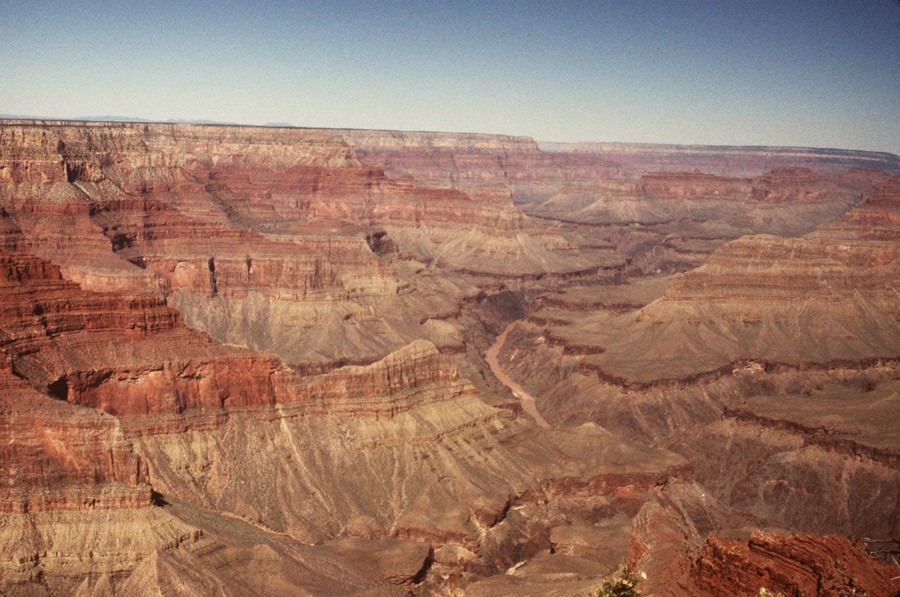Young-Earth Creationism
and the
Geology of the Grand Canyon
Text and Photographs by Jon Woolf
Summary and Conclusion
So, now we've looked at the geology of the Colorado Plateau and the geology of the Grand Canyon cut into the Plateau. We've looked at the explanations offered for each of these: the Young-Earther explanation, and the explanation offered by conventional geology. Which position better explains the observed features of the Colorado Plateau and the Grand Canyon?
I don't think there can be any doubt that Steven Austin's young-Earth, catastrophic model for the formation of the Colorado Plateau and the Grand Canyon fails in a great many ways. It does not explain the known facts, despite calling on a number of unjustifiable ad hoc hypotheses. It is internally contradictory, as well as inconsistent with the known evidence. Quite simply, it doesn't work, and there doesn't appear to be any way to salvage it so that it does work. Rationally, the only conclusion is that Austin's model fails, and it must be discarded.
By contrast, the conventional theory for the formation of the rocks of the Colorado Plateau works quite well. There are one or two unexplained anomalies, but these are relatively minor and may well be explained by further research. The conventional theory for the formation of the Canyon is not on nearly as firm ground; it seems incomplete at best, but the general outline seems to match and there does seem to be some maneuvering room where the model can be adjusted to better fit the available evidence. The conventional theory isn't perfect, but it definitely is far better than the catastrophist theory, so it should stay unless and until someone can come up with something better.

Vista of the Grand Canyon from Mohave Point, West Rim Drive. On the left, the South Rim shows off every layer in the Upper Canyon, while the Inner Gorge is visible at right.
The majesty of the Grand Canyon of the Colorado River stands as a mute monument to the vast depths of time: time represented by the rocks, and time represented by the canyon through those rocks. No model of Earth history can be accepted unless it explains the Grand Canyon. The facts given in this article demonstrate clearly that Steve Austin's young-Earth model for the Grand Canyon is a complete failure. Further, it shows that the same questions and objections which kill Austin's model will also kill any other model that only allows a few thousand years for the history of the Plateau and the Canyon. No young-Earth model will ever survive the test of the Grand Canyon, and that means that no young-Earth model of Earth history can ever be accepted at all.
Related Web Links:
"Grand Canyon Rock Layers" and "Geology of the Grand Canyon" have additional views and explanations of Grand Canyon geology.
"Grand Canyon Lava Flows: A Survey of Isotope Dating Methods" and "Excessively Old 'Ages' for Grand Canyon Lava Flows" are two of Steve Austin's articles on radiometric dating of Grand Canyon rocks.
"A Criticism of ICR's Grand Canyon Dating Project" is Chris Stassen's article criticizing Austin's work.
Bibliography and Further Reading:
GEOLOGY OF THE GRAND CANYON
Various authors
c. 1976, Museum of Northern Arizona
GRAND CANYON COUNTRY
National Geographic Park Profiles
Seymour L. Fishbein
c. 1997, The National Geographic Society
ISBN 0-7922-7032-0
GRAND CANYON: MONUMENT TO CATASTROPHE
Steven A. Austin
c. 1994, Institute for Creation Research
ISBN 0-932766-33-1
GRAND CANYON: THE GREAT ABYSS
Page Stegner
c. 1995, Tehabi Books
ISBN 0-06-258564-9
GRAND CANYON GEOLOGY
Stanley Beus and Michael Morales, editors
c. 1990, Oxford University Press
ISBN 0-19-505015-0
PAGES OF STONE: GRAND CANYON AND THE PLATEAU COUNTRY
Halka Chronic
c. 1988, The Mountaineers
ISBN 0-89886-155-1